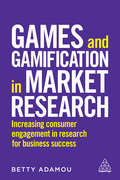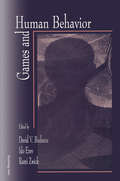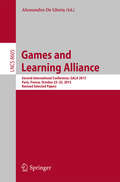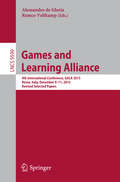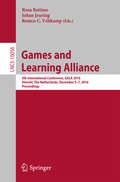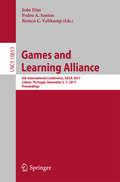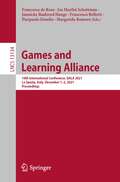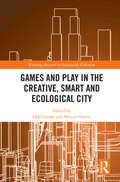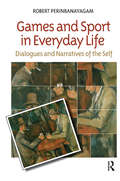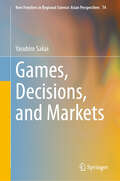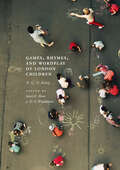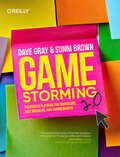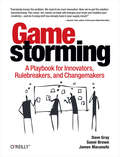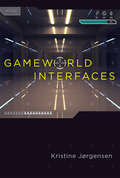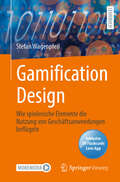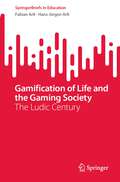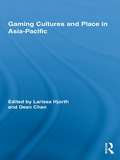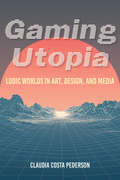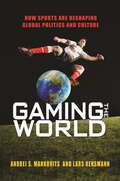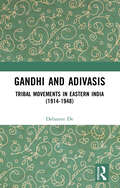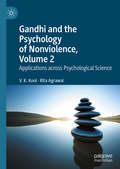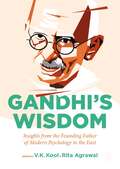- Table View
- List View
Games and Gamification in Market Research: Increasing Consumer Engagement in Research for Business Success
by Betty AdamouGames are the most engaging medium of all time: they harness storytelling and heuristics, drive emotion and push the evolution of technology in a way that no other platform has or can. It's no surprise, then, that games and gamification are revolutionizing the market research industry, offering opportunities to reinvigorate the notoriously sluggish engagement levels seen in traditional surveying methods. This not only improves data quality, but offers untapped insights unattainable through traditional methods. Games and Gamification in Market Research shows readers how to design ResearchGames and Gamified Surveys that will intrinsically engage participants and how best to use these methodologies to become, and stay, commercially competitive. In a world where brands and organizations are increasingly interested in the feelings and contexts that drive consumer choices, Games and Gamification in Market Research gives readers the skills to use the components in games to encourage play and observe consumer behaviours via simulations for predictive modelling. Written by Betty Adamou, the UK's leading research game designer and named as one of seven women shaping the future of market research, it explains the ways in which these methodologies will evolve with technologies such as virtual reality and artificial intelligence, and how it will shape research careers. Alongside a companion website, this book provides a fully immersive and fascinating overview of game-based research.
Games and Human Behavior: Essays in Honor of Amnon Rapoport
by Ido Erev Rami Zwick David V. BudesenHuman behavior often violates the predictions of rational choice theory. This realization has caused many social psychologists and experimental economists to attempt to develop an experimentally-based variant of game theory as an alternative descriptive model. The impetus for this book is the interest in the development of such a theory that combines elements from both disciplines and appeals to both. The editors have brought together leading researchers in the fields of experimental economics, behavioral game theory, and social dilemmas to engage in constructive dialogue across disciplinary boundaries. This book offers a comprehensive overview of the new insights into the motivation of human behavior under a variety of naturally or artificially induced incentive structures that are emerging from their work. Amnon Rapoport--a pioneer and leader in experimental study and quantitative modeling of human decisions in social and interactive contexts--is honored.
Games and Learning Alliance
by Alessandro De GloriaThis book constitutes the refereed proceedings of the Third International Conference on Games and Learning Alliance, GALA 2014, held in Bucharest, Romania, in July 2014. The 15 revised papers presented were carefully reviewed and selected from 26 submissions. The papers presented cover a variety of aspects and knowledge fields. They are grouped into four sessions: pedagogy, technology, design, and applications.
Games and Learning Alliance
by Remco Veltkamp Alessandro De GloriaThis book constitutes the refereed proceedings of the 4th International Conference on Games and Learning Alliance, GALA 2015, held in Rome, Italy, in December 2015. The 33 revised full papers and 15 short papers presented were carefully reviewed and selected from 102 submissions. The papers presented cover a variety of aspects and knowledge fields. They are grouped around the following topics: games for health, games for mobility, pervasive gaming and urban mobility.
Games and Learning Alliance
by Rosa Bottino Johan Jeuring Remco C. VeltkampThis book constitutes the refereed proceedings of the 5th International Conference on Games and Learning Alliance, GALA 2016, held in Utrecht, The Netherlands, in December 2016. The 27 revised regular papers presented together with 14 poster papers were carefully reviewed and selected from 55 submissions. The papers cover topics such as games and sustainability; games for math and programming; games and health; games and soft skills; games and management; games and learning; game development and assessment; and mobile games.
Games and Learning Alliance
by João Dias Remco C. Veltkamp Pedro A. SantosThis book constitutes the refereed proceedings of the 6th International Conference on Games and Learning Alliance, GALA 2017, held in Lisbon, Portugal, in December 2017. The 16 revised regular papers presented together with 6 poster papers were carefully reviewed and selected from 45 submissions. The papers cover topics such as games in education and training; games for health and special children; augmented and virtual reality; methods and tools (for desing and development); and poster abstracts.
Games and Learning Alliance: 10th International Conference, GALA 2021, La Spezia, Italy, December 1–2, 2021, Proceedings (Lecture Notes in Computer Science #13134)
by Margarida Romero Jannicke Baalsrud Hauge Francesco Bellotti Francesca De Rosa Iza Marfisi Schottman Pierpaolo DondioThis book constitutes the refereed proceedings of the 10th International Conference on Games and Learning Alliance, GALA 2021, held in La Spezia, Italy, in December 2021. The 21 full papers and 10 short papers were carefully reviewed and selected from 50 submissions. The papers cover a broad spectrum of topics: Serious Games Applications; Serious Game to Improve Literacy; Technology used for Serious Games; Serious Game Usage; Serious Games Design.
Games and Play in the Creative, Smart and Ecological City (Routledge Research in Sustainable Urbanism)
by Dale Leorke Marcus OwensThis book explores what games and play can tell us about contemporary processes of urbanization and examines how the dynamics of gaming can help us understand the interurban competition that underpins the entrepreneurialism of the smart and creative city. Game and Play in the Creative, Smart and Ecological City is a collection of chapters written by an interdisciplinary group of scholars from game studies, media studies, play studies, architecture, landscape architecture and urban planning. It situates the historical evolution of play and games in the urban landscape and outlines the scope of the various ways games and play contribute to the city’s economy, cultural life and environmental concerns. In connecting games and play more concretely to urban discourses and design strategies, this book urges scholars to consider their growing contribution to three overarching sets of discourses that dominate urban planning and policy today: the creative and cultural economies of cities; the smart and playable city; and ecological cities. This interdisciplinary work will be of great interest to students and scholars of game studies, play studies, landscape architecture (and allied design fields), urban geography, and art history.
Games and Sport in Everyday Life: Dialogues and Narratives of the Self
by Robert S. Perinbanayagam"This is a powerful, richly nuanced, evocative work; a stunning and brilliantly innovative pedagogical intervention. It provides ground zero-the starting place for the next generation of theorists who study the self, narrative theory, and the place of games and sport in everyday life. A stunning accomplishment by one of America's major social theorists." Norman K. Denzin, University of Illinois at Urbana-Champaign Games of many kinds have been played in all cultures throughout human history. This wide-ranging book explores the social and psychological processes involved in the playing of games. One player (or team) seeks to outwit another by undertaking various physical and communicative moves-not unlike conversations. Games have well-formed "narrative" structures, analogous to myths, that are enacted by each participant to give play to his/her self and its attendant emotions. These plays of the self enable each agent to seek adventures and heroic moments. Going beyond the mythmaking and catharsis that may be achieved by individuals, the author shows how games have been devised and played in particular societies and eras as means of promoting specific ideologies of a society, even social ideals such as utopias.
Games, Decisions, and Markets (New Frontiers in Regional Science: Asian Perspectives #74)
by Yasuhiro SakaiThis book critically discusses the historical backgrounds and new developments of the theories of games, decisions, and markets, with many possible applications to social and economic problems. Consisting of three connected parts, the book sheds new light on the role of merchants in the market economy under conditions of risk and uncertainty. Part I begins with the question of why and how John von Neumann and Oskar Morgenstern did joint work in game theory, namely, the theoretical study of strategic interactions among several decision makers. The duel between Sherlock Holmes and Professor Moriarty in Conan Doyle's famous detective story is recalled as a great inducement to Neumann and Morgenstern to invent zero-sum, two-person games. More general non-zero-sum games and associated Nash solutions are then discussed in relation to the generation-gap problem between a young couple and an elderly couple. Part II explores a set of very fundamental problems of individual decision making. Thetwo famous axioms of revealed preference ― Samuelson's weak axiom and Houthakker's axiom ― are skillfully connected and empirically reevaluated by the introduction of certain regularity conditions. The revealed preference approach is then extended from the original commodity space to the dual price space. Such dual treatment in microeconomics is further applied to the theory of cost and production, with the decomposition of the total factor price effect into the substitution and scale effects. Part III turns the reader’s attention to the interdependence of several markets. The almost forgotten Hicks–Morishima approach is newly revived with graphical illustrations of traded goods. The well-known Jones–Kemp approach to international trade is boldly expanded into the world of risk and uncertainty. Some striking results in comparative static analysis are derived, with favorable implications for the real world.
Games, Rhymes, and Wordplay of London Children
by N. G. KelseyThis book presents a unique annotated collection of some 2000 playground games, rhymes, and wordplay of London children. It charts continuity and development in childlore at a time of major social and cultural change and offers a detailed snapshot of changes in the traditions and language of young people. Topics include: starting a game; counting-out rhymes; games (without songs); singing and chanting games; clapping, skipping, and ball bouncing games; school rhymes and parodies; teasing and taunting; traditional belief and practice; traditional wordplay; and a concluding miscellany. Recorded mainly in the 1980s by primary schoolteacher Nigel Kelsey, transcribed verbatim from the children’s own words, and accompanied by extensive commentaries and annotation, the book sets a wealth of new information in the wider historical and contemporary context of existing studies in Britain, Ireland, and other parts of the English-speaking world. This valuable new resource will open new avenues for research and be of particular interest to folklorists and linguists, as well as to those working across the full spectrum of social, cultural, and educational studies.
Gamestorming 2.0: An Updated Playbook for Innovators, Rule Breakers, and Changemakers
by Sunni Brown Dave GrayIn today's environment of partial attention and isolating remote work, few things are more satisfying than group experiences that produce powerful, meaningful connections and output. But this kind of enlivening, collective work doesn't happen by chance. It must be consciously designed and purposefully activated--;in a team, an organization, and a culture. The good news is that making space for this kind of work doesn't have to be hard. There's a technique available to everyone, with no special certification required: gamestorming. This substantial update to the best-selling O'Reilly book now includes three new chapters and 95 games. The authors identified and curated techniques from some of the world's most innovative professionals as well as inventing games of their own. This book is the result: a unique collection of approaches to simultaneously ignite engagement and level-up creative teamship while bringing agility and structure to gatherings at work in person and online. Shorten meetings and make them significantly more productive Increase efficacy and engagement in strategic thinking and problem-solving Enhance connection and communication across team members Elevate collaboration and uncover surprising solutions to sticky problems Generate better ideas and significantly improve remote work experiences
Gamestorming: A Playbook for Innovators, Rulebreakers, and Changemakers (O'reilly Ser.)
by James Macanufo Sunni Brown Dave GrayGreat things don't happen in a vacuum. But creating an environment for creative thinking and innovation can be a daunting challenge. How can you make it happen at your company? The answer may surprise you: gamestorming.This book includes more than 80 games to help you break down barriers, communicate better, and generate new ideas, insights, and strategies. The authors have identified tools and techniques from some of the world's most innovative professionals, whose teams collaborate and make great things happen. This book is the result: a unique collection of games that encourage engagement and creativity while bringing more structure and clarity to the workplace. Find out why -- and how -- with Gamestorming.Overcome conflict and increase engagement with team-oriented gamesImprove collaboration and communication in cross-disciplinary teams with visual-thinking techniquesImprove understanding by role-playing customer and user experiencesGenerate better ideas and more of them, faster than ever beforeShorten meetings and make them more productiveSimulate and explore complex systems, interactions, and dynamicsIdentify a problem's root cause, and find the paths that point toward a solution
Gameworld Interfaces
by Kristine JorgensenAn investigation into computer game interfaces, both naturalistic and symbolic, and the distinction between gameworlds and other kinds of fictional worlds. Computer games usually take one of two approaches to presenting game information to players. A game might offer information naturalistically, as part of the game's imaginary universe; or it might augment the world of the game with overlays, symbols, and menus. In this book, Kristine Jørgensen investigates both kinds of gameworld interfaces. She shows that although the naturalistic approach may appear more integral to the imaginary world of the game, both the invisible and visible interfaces effectively present information that players need in order to interact with the game and its rules. The symbolic, less naturalistic approach would seem to conflict with the idea of a coherent, autonomous fictional universe; but, Jørgensen argues, gameworlds are not governed by the pursuit of fictional coherence but by the logics of game mechanics. This is characteristic of gameworlds and distinguishes them from other traditional fictional worlds. Jørgensen investigates gameworld interfaces from the perspectives of both game designers and players. She draws on interviews with the design teams of Harmonix Music (producer of Rock Band and other music games) and Turbine Inc. (producer of such massively multiplayer online games as Lord of the Rings Online), many hours of gameplay, and extensive interviews and observations of players. The player studies focus on four games representing different genres: Crysis, Command & Conquer 3: Tiberian Wars, The Sims 2, and Diablo 2. Finally, she presents a theory of game user interfaces and considers the implications of this theory for game design.
Gameworld Interfaces
by Kristine JørgensenComputer games usually take one of two approaches to presenting game information to players. A game might offer information naturalistically, as part of the game's imaginary universe; or it might augment the world of the game with overlays, symbols, and menus. In this book, Kristine Jørgensen investigates both kinds of gameworld interfaces. She shows that although the naturalistic approach may appear more integral to the imaginary world of the game, both the invisible and visible interfaces effectively present information that players need in order to interact with the game and its rules. The symbolic, less naturalistic approach would seem to conflict with the idea of a coherent, autonomous fictional universe; but, Jørgensen argues, gameworlds are not governed by the pursuit of fictional coherence but by the logics of game mechanics. This is characteristic of gameworlds and distinguishes them from other traditional fictional worlds. Jørgensen investigates gameworld interfaces from the perspectives of both game designers and players. She draws on interviews with the design teams of Harmonix Music (producer of Rock Band and other music games) and Turbine Inc. (producer of such massively multiplayer online games as Lord of the Rings Online), many hours of gameplay, and extensive interviews and observations of players. The player studies focus on four games representing different genres: Crysis, Command & Conquer 3: Tiberian Wars, The Sims 2, and Diablo 2. Finally, she presents a theory of game user interfaces and considers the implications of this theory for game design.
Gamification Design: Wie spielerische Elemente die Nutzung von Geschäftsanwendungen beflügeln
by Stefan WagenpfeilGamification hat längst den Bereich der Computerspiele verlassen und ist zu einem wichtigen Werkzeug geworden, um Anwendungen zu entwickeln, die Benutzer*innen fördern, fordern und fesseln. In diesem Buch werden die Konzepte der Gamification, grundlegende Modelle und deren Anwendungsbereiche behandelt. Zudem erhalten Sie konkrete Handlungsempfehlungen und Herangehensweisen für die praktische Umsetzung. Sie benötigen keine Programmierkenntnisse, sollten jedoch Interesse an technischen und theoretischen Zusammenhängen mitbringen, um mithilfe von Gamification gezielt Ihre Anwendungen zu planen und umzusetzen. Erfahren Sie, wie Sie mit Gamification mehr Akzeptanz und Effizienz erreichen können. Das Lehrbuch führt ein solides wissenschaftliches Fundament ein, auf dem dann die tiefergehenden Konzepte angewandt und anhand diverser Fallbeispiele illustriert werden. Es eignet sich für Studierende der Informatik, Wirtschaftsinformatik oder Betriebswirtschaft (mit technischem Interesse), sowie IT-Manager, Software-Architekten oder Product Owner in Unternehmen. Zusätzliche Fragen per App: Laden Sie die Springer-Nature-FlashcardsApp kostenlos herunter und nutzen Sie exklusives Zusatzmaterial, um Ihr Wissen zu prüfen.
Gamification of Life and the Gaming Society: The Ludic Century (SpringerBriefs in Education)
by Hans-Jürgen Arlt Fabian ArltThis interesting book discusses why, as an activity, topic and metaphor, play and game have become an integral part of modern life. Empirically exemplary and theoretically grounded, this book discusses the developments and expansions in gaming, from easily accessible casual games to the galaxy-spanning gaming worlds of Massively Multiplayer Online Role-Playing Games (MMORPGs). It shows how gaming has become a focal point of the entertainment industry, marked by boundless professionalization and monetization, especially in the realm of sports, and how games become global platforms for social networks, where players from all over the world meet in digital sandboxes. The combination of the virtual and the ludic creates hyperreal spaces in which people try out new forms of interaction, cooperation, and even brainstorming. The authors ask if this behavior has become the new way of life and the new normal, and if this heralds the ludic century. They take readers on a journey to understand the dynamics of today's gaming society, and base their observations and analyses on an original theory of play, which, in contrast to social normalcy, revolves around the allure and threats of the unexpected. This book is of interest to students and researchers of social science and communication studies, especially those working on the interface of AI and society.
Gaming Culture(s) in India: Digital Play in Everyday Life
by Aditya DeshbandhuThis volume critically analyzes the multiple lives of the "gamer" in India. It explores the "everyday" of the gaming life from the player’s perspective, not just to understand how the games are consumed but also to analyze how the gamer influences the products’ many (virtual) lives. Using an intensive ethnographic approach and in-depth interviews, this volume situates the practice of gaming under a broader umbrella of digital leisure activities and foregrounds the proliferation of gaming as a new media form and cultural artifact; critically questions the term gamer and the many debates surrounding the gamer tag to expand on how the gaming identity is constructed and expressed; details participants’ gaming habits, practices and contexts from a cultural perspective and analyzes the participants’ responses to emerging industry trends, reflections on playing practices and their relationships to friends, communities and networks in gaming spaces; and examines the offline and online spaces of gaming as sites of contestation between developers of games and the players. A holistic study covering one of the largest video game bases in the world, this volume will be of great interest to scholars and researchers of cultural studies, media and communication studies and science and technology studies, as well as be of great appeal to the general reader.
Gaming Cultures and Place in Asia-Pacific (Routledge Studies in New Media and Cyberculture)
by Larissa Hjorth Dean ChanThis collection explores the relationship between digital gaming and its cultural context by focusing on the burgeoning Asia-Pacific region. Encompassing key locations for global gaming production and consumption such as Japan, China, and South Korea, as well as increasingly significant sites including Australia and Singapore, the region provides a wealth of divergent examples of the role of gaming as a socio-cultural phenomenon. Drawing from micro ethnographic studies of specific games and gaming locales to macro political economy analyses of techno-nationalisms and trans-cultural flows, this collection provides an interdisciplinary model for thinking through the politics of gaming production, representation, and consumption in the region.
Gaming Utopia: Ludic Worlds in Art, Design, and Media
by Claudia Costa PedersonIn Gaming Utopia: Ludic Worlds in Art, Design, and Media, Claudia Costa Pederson analyzes modernist avant-garde and contemporary video games to challenge the idea that gaming is an exclusively white, heterosexual, male, corporatized leisure activity and reenvisions it as a catalyst for social change. By looking at over fifty projects that together span a century and the world, Pederson explores the capacity for sociopolitical commentary in virtual and digital realms and highlights contributions to the history of gaming by women, queer, and transnational artists. The result is a critical tool for understanding video games as imaginative forms of living that offer alternatives to our current reality. With an interdisciplinary approach, Gaming Utopia emphasizes how game design, creation, and play can become political forms of social protest and examines the ways that games as art open doors to a more just and peaceful world.
Gaming in Social, Locative, and Mobile Media
by Larissa Hjorth Ingrid RichardsonDrawing on case studies across the Asia-Pacific region, Gaming in Social, Locative and Mobile Media explores the 'playful turn' in contemporary everyday life, and the role of mobile devices, games and social media in this transformation.
Gaming the World: How Sports Are Reshaping Global Politics and Culture
by Andrei S. Markovits Lars RensmannThe globalizing influence of professional sportsProfessional sports today have truly become a global force, a common language that anyone, regardless of their nationality, can understand. Yet sports also remain distinctly local, with regional teams and the fiercely loyal local fans that follow them. This book examines the twenty-first-century phenomenon of global sports, in which professional teams and their players have become agents of globalization while at the same time fostering deep-seated and antagonistic local allegiances and spawning new forms of cultural conflict and prejudice.Andrei Markovits and Lars Rensmann take readers into the exciting global sports scene, showing how soccer, football, baseball, basketball, and hockey have given rise to a collective identity among millions of predominantly male fans in the United States, Europe, and around the rest of the world. They trace how these global—and globalizing—sports emerged from local pastimes in America, Britain, and Canada over the course of the twentieth century, and how regionalism continues to exert its divisive influence in new and potentially explosive ways. Markovits and Rensmann explore the complex interplay between the global and the local in sports today, demonstrating how sports have opened new avenues for dialogue and shared interest internationally even as they reinforce old antagonisms and create new ones.Gaming the World reveals the pervasive influence of sports on our daily lives, making all of us citizens of an increasingly cosmopolitan world while affirming our local, regional, and national identities.
Gandhi and Adivasis: Tribal Movements in Eastern India (1914-1948)
by Debasree DeAdivasi movements played a very important, if not determining, role in the India’s freedom struggle. Gandhi’s idea of mass mobilization couldn’t have been successful without the active participation of all sections of the Indian society. Adivasi movements were swelled by Gandhian ideology only during the Non-Cooperation movement. Though Gandhi’s interest in the tribal problems crystallized at a later stage of his life, his influence on tribal movements was revealing. His association with Thakkar Bapa and Verrier Elwin also enriched his knowledge about tribal state of affairs. Adivasis started looking at Gandhi as saviour or a saint, who could deliver them justice and peace. But, Gandhi always supported Adivasi movements in order to give a mass character to his movements. There were some particular demands of the Adivasis that were not supported by Gandhi. Their armed struggle was also against his non-violent principles. During the latter half of the twentieth century, movements like Tana Bhagat and Hari Baba were purely influenced by the Gandhian ideology, but failed to achieve their goals. Later on, the Jharkhand movement adopted the character of a non-violent struggle; here also the fruits disappeared. The present work focuses on the first three movements of the Chota Nagpur Plateau of eastern India during Gandhi’s lifetime and the current movements against forceful displacement by POSCO, Vedanta and others, in order to comprehend his ideological impact on Adivasi movements of today. The book has critically analysed and evaluated Gandhi’s impact on the Adivasi situation in colonial and post-colonial India. Please note: Taylor & Francis does not sell or distribute print edition in India, Pakistan, Nepal, Bhutan, Bangladesh and Sri Lanka.
Gandhi and the Psychology of Nonviolence, Volume 2: Applications across Psychological Science
by Rita Agrawal V. K. KoolIn volume 1 of Gandhi and the Psychology of Nonviolence the authors advanced a scientific psychology of nonviolence, derived from principles enunciated by Gandhi and supported by current state-of-the-art research in psychology. In this second volume the authors demonstrate its potential contribution across a wide range of applied psychology fields. As we enter the era of the Anthropocene, they argue, it is imperative to make use of Gandhi’s legacy through our evolving noospheric consciousness to address the urgent problems of the 21st century. The authors examine Gandhi’s contributions in the context of both established areas such as the psychology of religion, educational, community and organizational psychology and newer fields including environmental psychology and the psychology of technology. They provide a nuanced analysis which engages with both the latest research and the practical implications for initiatives like the Intergovernmental Panel on Climate Change and the UN’s Sustainable Development Goals.The book concludes with an overview of Gandhi’s contribution to modern psychology, which encompasses the history, development, and current impetus behind emerging work in the field as a whole. It marks an exciting contribution to studies of both Gandhi and psychology that will also provide unique insights for scholars of applied psychology, education, environmental and development studies.
Gandhi’s Wisdom: Insights from the Founding Father of Modern Psychology in the East
by V. K. Kool Rita AgrawalThis book examines what Gandhian thought contributes to the conceptualisation of wisdom and its application in the 21st Century. It draws together leading international researchers and practitioners to combine an in-depth understanding of Gandhi’s philosophy with the latest research from psychology and allied social sciences. Beginning with an overview of wisdom in the domain of scientific research and as it is understood in our everyday life, the book’s editors further call attention to key cross cultural issues limiting its current scope. Amongst the topics explored are Gandhi’s silence, fasting, vows, self-efficacy, self-control, and more, illustrating what he offers not only to the study of wisdom within psychology, but across a broad range of disciplines and professional enterprises. It is invaluable to students and scholars of Gandhian studies, the psychology of wisdom, management and peace psychology; as well to readers with a general interest in the application of Gandhi’s wisdom today.
